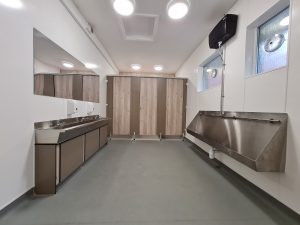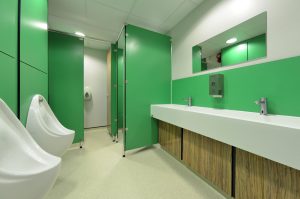Discover the 10 essential features that every nursery school toilet should have, ensuring a safe and hygienic environment for our little ones to learn and grow. From child-friendly designs to innovative technology, these features are carefully curated to meet the unique needs of young children. We understand the importance of providing a comfortable and inviting space for our young learners, and that starts with the place where they take care of their personal needs. In this comprehensive guide, we will explore features such as adjustable toilet seats, easy-to-reach sinks, and child-sized fixtures, all aimed at creating a positive and enjoyable toilet experience for children. Whether you are a parent, teacher, or school administrator, this article will equip you with the knowledge needed to create a nurturing environment that fosters independence and hygiene habits in our youngest learners. So, let’s dive in and discover the must-have features that every nursery school toilet should possess.
Safety Features for Nursery School Toilets
When it comes to nursery school toilets, safety should always be a top priority. These features are designed to minimize accidents and create a secure environment for children to use the facilities independently.
- Slip-Resistant Flooring: Slippery floors can be a significant hazard in a nursery school toilet. Installing slip-resistant flooring materials, such as rubber or textured tiles, can greatly reduce the risk of slips and falls, providing a safe and secure environment for children.
- Childproof Locks: Childproof locks on toilet cubicle doors are essential to prevent accidents and ensure the privacy and safety of children using the facilities. These locks should be easy for adults to open in case of emergencies but secure enough to prevent unauthorized access.
- Soft-Close Toilet Seats: Soft-close toilet seats help prevent finger injuries and reduce the risk of children accidentally slamming the seat shut. This feature adds an extra layer of safety and prevents unnecessary accidents.
Hygiene Features for Nursery School Toilets
Maintaining proper hygiene in a nursery school toilet is crucial for the health and well-being of children. Incorporating these features can help promote cleanliness and minimize the spread of germs.
- Hands-Free Dispensers: Installing hands-free soap dispensers, hand dryers, and paper towel dispensers can significantly reduce the spread of germs. These touchless options minimize contact with surfaces and promote proper hand hygiene practices.
- Easy-to-Clean Surfaces: Choosing materials that are easy to clean and disinfect is essential for maintaining a hygienic nursery school toilet. Non-porous surfaces, such as stainless steel or porcelain, are ideal as they are resistant to stains and bacteria growth.
- Adequate Waste Disposal: Proper waste disposal is crucial to maintain hygiene standards in a nursery school toilet. Installing hands-free waste bins with lids helps contain odors and prevents the spread of germs.
Accessibility Features for Nursery School Toilets
Accessibility features are vital to ensure that children of all abilities can use the toilet facilities comfortably and independently.
- Support Rails: Installing support rails near the toilet can provide stability and support for children with physical disabilities or those who require assistance. These rails should be securely fixed and designed to be at an appropriate height for children.
- Wheelchair Accessible Facilities:** Ensuring that there are wheelchair-accessible toilets and sinks available is essential for children with mobility challenges. These facilities should be spacious enough to accommodate a wheelchair and equipped with appropriate features for easy use.
- Visual Prompts: Visual prompts, such as pictures or symbols, can help children with cognitive disabilities understand and follow toilet routines. These prompts can be placed above the toilet or near the sink to provide visual cues for children.
Size and Layout Considerations for Nursery School Toilets
The size and layout of a nursery school toilet play a significant role in creating a comfortable and functional space for young children.
- Adequate Space: Ensuring that there is enough space in the toilet cubicles for children to move comfortably is crucial. Cubicles should be designed with enough room for children to turn around and access the toilet and sink independently.
- Wide Entryways: Wide entryways to the toilet area make it easier for children to enter and exit, especially when accompanied by an adult or carrying bags. It also allows for easy access in case of emergencies.
- Bright Lighting: Ample lighting in the toilet area is essential to create a welcoming and safe environment. Bright lighting helps children feel secure and reduces the risk of accidents.
Privacy Features for Nursery School Toilets
Privacy is a fundamental aspect of a nursery school toilet, ensuring that children feel comfortable and respected while using the facilities.
- Dividers between Toilets: Installing dividers between toilets provides children with a sense of privacy and encourages independence. Dividers can be made from durable and easy-to-clean materials such as plastic or laminate.
- Privacy Screens: Privacy screens near the sinks can provide a visual barrier and create a sense of privacy for children washing their hands. These screens can be designed to match the overall aesthetics of the toilet area.
- Covered Waste Bins: Using covered waste bins helps maintain privacy and discretion for children disposing of waste. This feature is particularly important for older children who may feel more self-conscious about their personal hygiene practices.
Durability and Easy Maintenance Features for Nursery School Toilets
Nursery school toilets should be designed to withstand heavy use and require minimal maintenance to ensure long-lasting functionality.
- Durable Fixtures: Choosing durable fixtures, such as stainless steel toilets and sinks, can withstand the wear and tear of daily use by young children. These fixtures are resistant to scratches, stains, and corrosion, ensuring longevity and reducing maintenance costs.
- Easy-to-Clean Surfaces: Opting for surfaces that are easy to clean and maintain is essential for a nursery school toilet. Smooth and non-porous materials, such as glazed tiles or solid surface countertops, can be easily wiped clean and disinfected, minimizing the risk of bacteria growth.
- Water-Efficient Fixtures: Installing water-efficient toilets and faucets not only helps conserve water but also reduces maintenance requirements. These fixtures are designed to minimize clogs and leaks, ensuring a hassle-free experience for both children and caregivers.
Child-Friendly Features for Nursery School Toilets
Creating a child-friendly environment in the nursery school toilet helps children feel comfortable and encourages independence in their personal hygiene routines.
- Colorful and Inviting Decor: Using bright and playful colors in the toilet area can make it more inviting for children. Incorporating child-friendly designs and decorations, such as cartoon characters or educational posters, can create a welcoming and engaging environment.
- Child-Sized Amenities: Child-sized fixtures, such as sinks, toilets, and mirrors, are essential for children to feel comfortable and confident using the facilities independently. These smaller-sized amenities are designed to accommodate the height and proportions of young children, promoting a sense of ownership and autonomy.
- Educational Signage: Placing educational signage in the toilet area can help reinforce hygiene practices and promote learning. Simple instructions or visual reminders about handwashing techniques and toilet etiquette can be displayed at child-friendly heights.
Eco-Friendly Features for Nursery School Toilets
Incorporating eco-friendly features in the nursery school toilet not only promotes sustainability but also teaches children the importance of caring for the environment.
- Water-Saving Fixtures: Installing water-saving toilets and faucets helps conserve water without compromising functionality. These fixtures are designed to use less water per flush or per use, reducing water wastage and promoting sustainable practices.
- Energy-Efficient Lighting: Using energy-efficient lighting, such as LED bulbs, can significantly reduce energy consumption in the toilet area. These bulbs are long-lasting and require less electricity, contributing to cost savings and environmental preservation.
- Recycling Bins: Encouraging recycling habits from a young age is crucial for instilling environmental awareness. Placing recycling bins in the toilet area allows children to dispose of waste responsibly and learn about the importance of recycling.
Conclusion: Creating a Safe and Comfortable Environment for Nursery School Children
Ensuring that every nursery school toilet is equipped with essential features is crucial in creating a safe, comfortable, and inviting environment for young children. From child-friendly designs to hygiene and accessibility features, each element plays a vital role in promoting independence, fostering healthy hygiene habits, and instilling a sense of respect and responsibility in our youngest learners. By investing in well-designed and well-maintained nursery school toilets, we can provide children with the foundation they need to thrive, learn, and grow. Let’s make every trip to the toilet a positive and enjoyable experience for our little ones.





